The Impact of Vinylotrimethoxysilane-Modified Linseed Oil on Selected Properties of Impregnated Wood
Abstract
:1. Introduction
2. Materials and Methods
2.1. Materials
2.2. Linseed Oil Modification
2.3. Methods
2.3.1. Non-Volatile Content/Solid Content
2.3.2. Determining the Viscosity of the Obtained Reaction Products
2.3.3. Water Absorption from Humid Air
2.3.4. Absorbability
2.3.5. Static Contact Angle
2.3.6. Determination of Changes in Wood Color
2.3.7. Resistance of Treated Wood to the Impact of Colonizing Fungi
Resistance to Colonization by the Fungi Causing Molding
Resistance to Decay Caused by C. puteana
2.3.8. ANOVA Analysis
3. Results and Discussion
3.1. Non-Volatile Content
3.2. Dynamic Viscosity
3.3. Absorption of Vapor from Humid Air
3.4. Absorbability
3.5. Static Contact Angle
3.6. Change of Color of the Protected Wood
3.7. Resistance of Wood to Biological Impacts
4. Conclusions
Author Contributions
Funding
Data Availability Statement
Conflicts of Interest
References
- Depczynska, E.; Mazela, B. Modern Bio-Based Wood Coatings-Potential for the Future. Surf. Coat. Int. 2019, 102, 78–83. [Google Scholar]
- Assanvo, E.F.; Gogoi, P.; Dolui, S.K.; Baruah, S.D. Synthesis, Characterization, and Performance Characteristics of Alkyd Resins Based on Ricinodendron Heudelotii Oil and Their Blending with Epoxy Resins. Ind. Crops Prod. 2015, 65, 293–302. [Google Scholar] [CrossRef]
- Athawale, V.D.; Nimbalkar, R.V. Waterborne Coatings Based on Renewable Oil Resources: An Overview. J. Am. Oil Chem. Soc. 2011, 88, 159–185. [Google Scholar] [CrossRef]
- Chang, C.-W.; Chang, J.-P.; Lu, K.-T. Synthesis of Linseed Oil-Based Waterborne Urethane Oil Wood Coatings. Polymers 2018, 10, 1235. [Google Scholar] [CrossRef] [Green Version]
- Hu, W.; Wan, H. Comparative Study on Weathering Durability Property of Phenol Formaldehyde Resin Modified Sweetgum and Southern Pine Specimens. Maderas. Cienc. Y Tecnol. 2022, 24. [Google Scholar] [CrossRef]
- Humar, M.; Lesar, B. Efficacy of Linseed-and Tung-Oil-Treated Wood against Wood-Decay Fungi and Water Uptake. Int. Biodeterior. Biodegrad. 2013, 85, 223–227. [Google Scholar] [CrossRef]
- Hill, C.A.; Farahani, M.M.; Hale, M.D. The Use of Organo Alkoxysilane Coupling Agents for Wood Preservation; De Gruyter: Berlin, Germany, 2004. [Google Scholar] [CrossRef]
- Lu, K.-T.; Chang, J.-P. Synthesis and Antimicrobial Activity of Metal-Containing Linseed Oil-Based Waterborne Urethane Oil Wood Coatings. Polymers 2020, 12, 663. [Google Scholar] [CrossRef] [Green Version]
- Farahani, M.R.M. Decay Resistance of Modified Wood; Bangor University: Bangor, UK, 2003; ISBN 1-68799-660-1. [Google Scholar]
- Liu, C.; Li, J.; Lei, W.; Zhou, Y. Development of Biobased Unsaturated Polyester Resin Containing Highly Functionalized Castor Oil. Ind. Crops Prod. 2014, 52, 329–337. [Google Scholar] [CrossRef]
- Veigel, S.; Lems, E.-M.; Grüll, G.; Hansmann, C.; Rosenau, T.; Zimmermann, T.; Gindl-Altmutter, W. Simple Green Route to Performance Improvement of Fully Bio-Based Linseed Oil Coating Using Nanofibrillated Cellulose. Polymers 2017, 9, 425. [Google Scholar] [CrossRef] [Green Version]
- Datta, J.; Głowińska, E. Effect of Hydroxylated Soybean Oil and Bio-Based Propanediol on the Structure and Thermal Properties of Synthesized Bio-Polyurethanes. Ind. Crops Prod. 2014, 61, 84–91. [Google Scholar] [CrossRef]
- Donath, S.; Militz, H.; Mai, C. Weathering of Silane Treated Wood. Holz Roh Werkst. 2007, 65, 35. [Google Scholar] [CrossRef]
- Islam, M.R.; Beg, M.D.H.; Jamari, S.S. Alkyd Based Resin from Non-Drying Oil. Procedia Eng. 2014, 90, 78–88. [Google Scholar] [CrossRef] [Green Version]
- Jebrane, M.; Cai, S.; Sandström, C.; Terziev, N. The Reactivity of Linseed and Soybean Oil with Different Epoxidation Degree towards Vinyl Acetate and Impact of the Resulting Copolymer on the Wood Durability. Express Polym. Lett. 2017, 11, 383. [Google Scholar] [CrossRef]
- Szubert, K. Synthesis of Organofunctional Silane from Rapeseed Oil and Its Application as a Coating Material. Cellulose 2018, 25, 6269–6278. [Google Scholar] [CrossRef] [Green Version]
- Panov, D.; Terziev, N. Study on Some Alkoxysilanes Used for Hydrophobation and Protection of Wood against Decay. Int. Biodeterior. Biodegrad. 2009, 63, 456–461. [Google Scholar] [CrossRef]
- Ratajczak, I.; Szentner, K.; Rissmann, I.; Mazela, B.; Hochmanska, P. Treatment Formulation Based on Organosilanes and Plant Oil Blend—Reactivity to Wood and Cellulose. Wood Res. 2012, 57, 265–270. [Google Scholar]
- Srinivasan, M. Synthesis, Properties and Applications of Bio-Based Materials; Materials Science and Engineering. Ph.D. Thesis, Michigan State University, East Lansing, MI, USA, 2010. [Google Scholar]
- Tambe, C.; Dewasthale, S.; Shi, X.; Graiver, D.; Narayan, R. Silylation of Non-Terminal Double Bonds of Natural Oils. Silicon 2016, 8, 87–98. [Google Scholar] [CrossRef]
- Depczynska, E.; Furgal, M.; Mazela, B.; Perdoch, W. Silylated Linseed Oil-Invisible Wood Protection? Surf. Coat. Int. 2019, 102, 22–26. [Google Scholar]
- Depczyńska, E.; Perdoch, W.; Mazela, B. Influence of Reaction Parameters on the Gelation of Silanised Linseed Oil. Materials 2020, 13, 5376. [Google Scholar] [CrossRef]
- Tambe, C.; Graiver, D.; Narayan, R. Moisture resistance coating of packaging paper from biobased silylated soybean oil. Prog. Org. Coat. 2016, 101, 270–278. [Google Scholar] [CrossRef] [Green Version]
- Temiz, A.; Kose, G.; Panov, D.; Terziev, N.; Alma, M.H.; Palanti, S.; Akbas, S. Effect of bio-oil and epoxidized linseed oil on physical, mechanical, and biological properties of treated wood. J. Appl. Polym. Sci. 2013, 130, 1562–1569. [Google Scholar] [CrossRef]
- Łucejko, J.J.; La Nasa, J.; McQueen, C.M.; Braovac, S.; Colombini, M.P.; Modugno, F. Protective effect of linseed oil varnish on archaeological wood treated with alum. Microchem. J. 2018, 139, 50–61. [Google Scholar] [CrossRef] [Green Version]
- Terziev, N.; Panov, D. Plant oils as “green” substances for wood protection. In Minimizing the Environmental Impact of the Forest Products Industries-Ecowood; Fernando Pessoa University: Porto, Portugal, 2010; pp. 143–149. [Google Scholar]
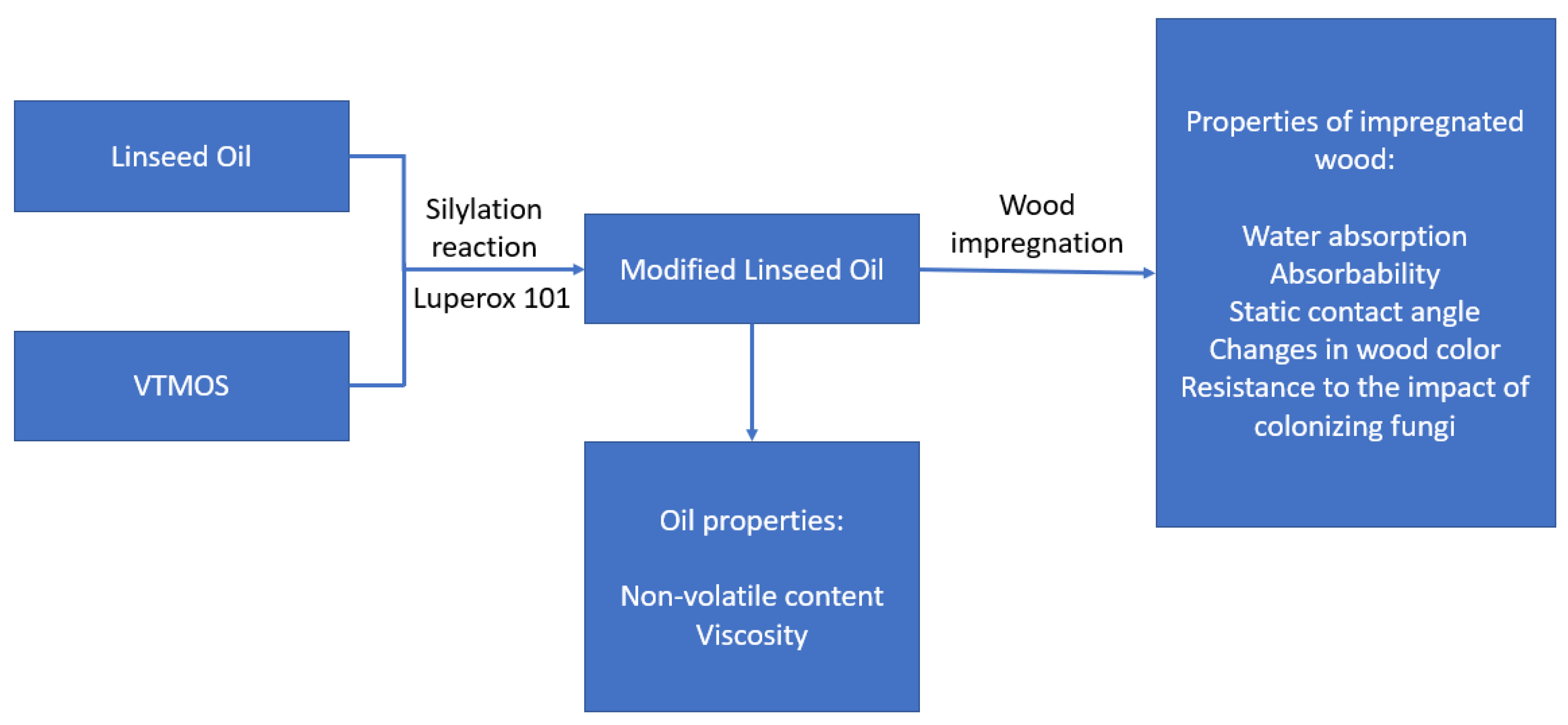


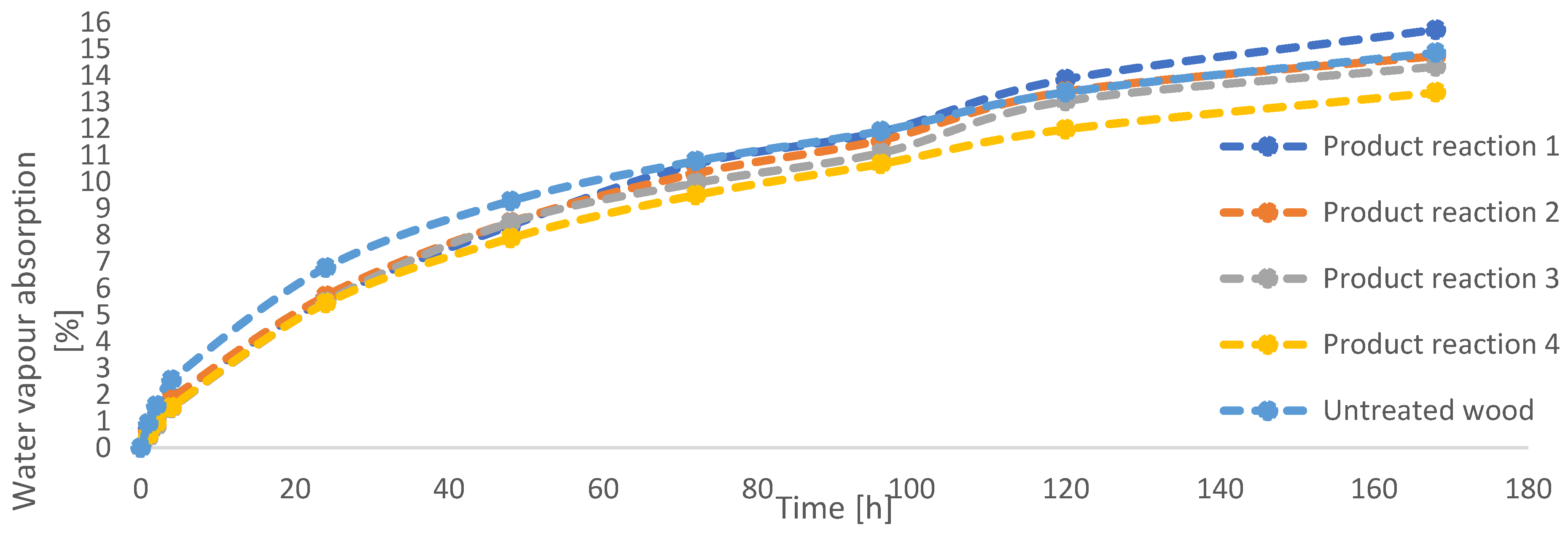

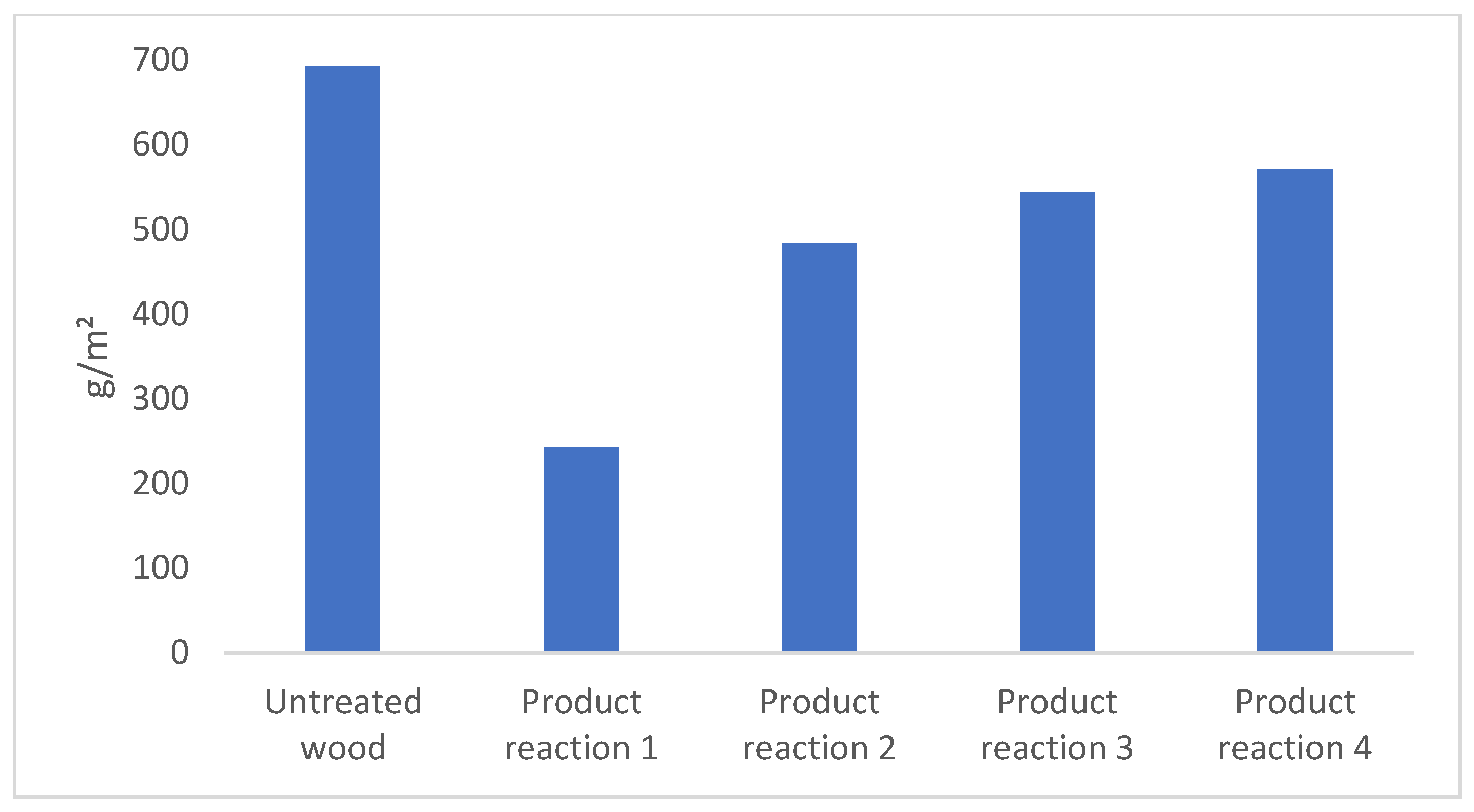
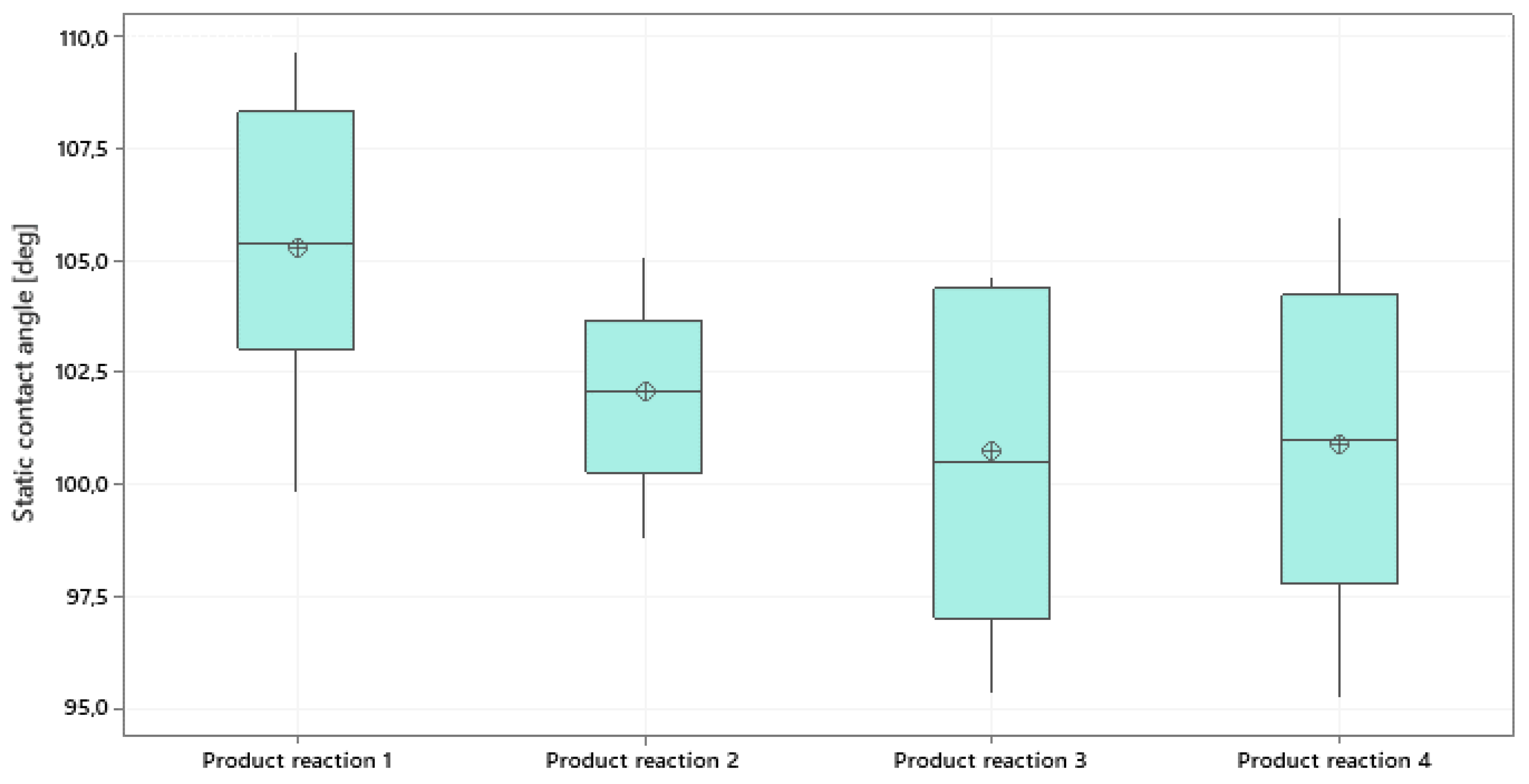

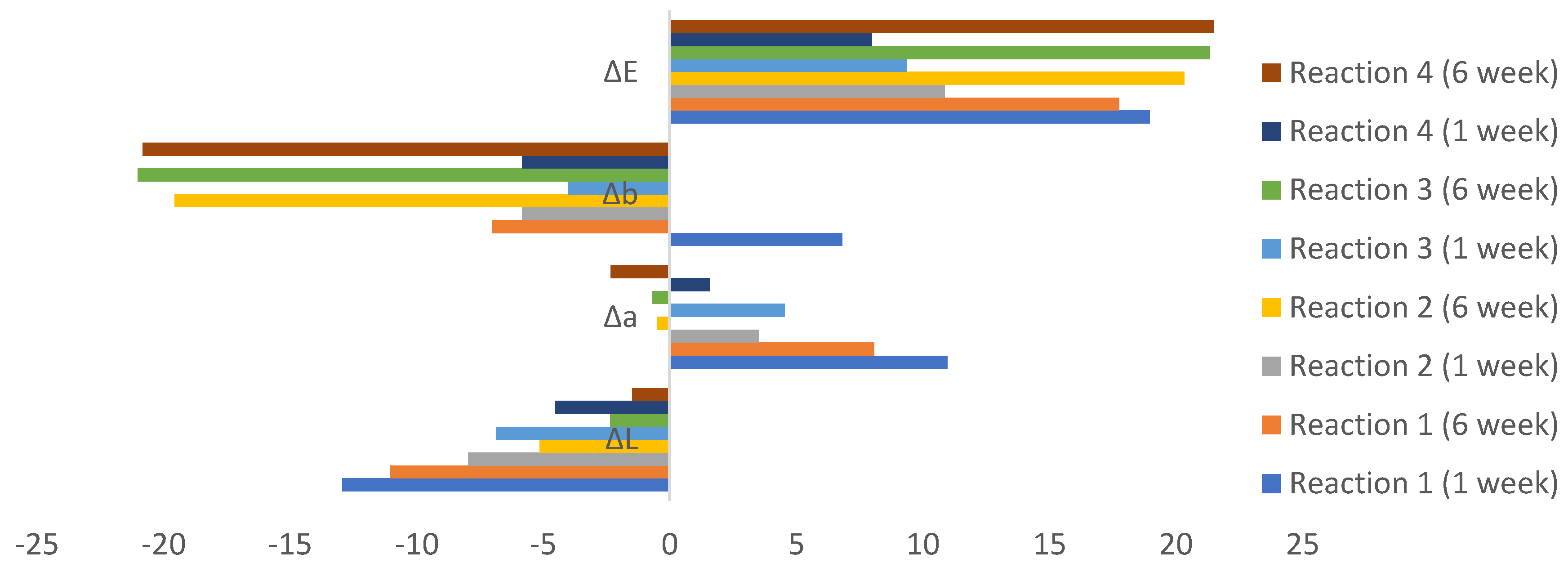

| Reaction ID | Luperox 101 [mol]/1 mol of Linseed Oil | VTMOS [mol]/1 mol of Linseed Oil | Time of VTMOS Addition | Reaction Time in 280 °C [h] |
|---|---|---|---|---|
| 1 | 0 | 0 | No addition | 12 |
| 2 | 0.008 | 0.6 | At the beginning of reaction | 3 |
| 3 | 0.04 | 0.6 | 3rd h of reaction | 6 |
| 4 | 0.04 | 0.6 | 3rd h of reaction | 9 |
| Index | Description |
|---|---|
| 0z | No colonization of the wood surface by fungi, visible zone of inhibition |
| 0 | No colonization of the wood surface by fungi |
| 1 | 1%–10% of the wood surface colonized by fungi |
| 2 | 11%–30% of the wood surface colonized by fungi |
| 3 | 31%–60% of the wood surface colonized by fungi |
| 4 | More than 60% of wood surface colonized by fungi |
| Sample ID | Wood Moisture Content [%] | Mass Loss |
|---|---|---|
| Product Reaction 1 | 36.9 ± 6.3 | 12.4 ± 1.8 |
| Product Reaction 1 (EN84) | 30.1 ± 4.2 | 11.5 ± 9.4 |
| Product Reaction 4 | 19.9 ± 1.7 | 3.6 ± 0.7 |
| Product Reaction 4 (EN84) | 19.5 ± 1.5 | 2.0 ± 0.8 |
| Untreated wood/fungi activity | 67.9 ± 5.4 | 21.8 ± 1.8 |
Publisher’s Note: MDPI stays neutral with regard to jurisdictional claims in published maps and institutional affiliations. |
© 2022 by the authors. Licensee MDPI, Basel, Switzerland. This article is an open access article distributed under the terms and conditions of the Creative Commons Attribution (CC BY) license (https://creativecommons.org/licenses/by/4.0/).
Share and Cite
Perdoch, W.; Depczyńska, E.; Tomkowiak, K.; Furgał, M.; Kurczak, M.; Mazela, B. The Impact of Vinylotrimethoxysilane-Modified Linseed Oil on Selected Properties of Impregnated Wood. Forests 2022, 13, 1265. https://doi.org/10.3390/f13081265
Perdoch W, Depczyńska E, Tomkowiak K, Furgał M, Kurczak M, Mazela B. The Impact of Vinylotrimethoxysilane-Modified Linseed Oil on Selected Properties of Impregnated Wood. Forests. 2022; 13(8):1265. https://doi.org/10.3390/f13081265
Chicago/Turabian StylePerdoch, Waldemar, Ewelina Depczyńska, Karolina Tomkowiak, Monika Furgał, Mariola Kurczak, and Bartłomiej Mazela. 2022. "The Impact of Vinylotrimethoxysilane-Modified Linseed Oil on Selected Properties of Impregnated Wood" Forests 13, no. 8: 1265. https://doi.org/10.3390/f13081265
APA StylePerdoch, W., Depczyńska, E., Tomkowiak, K., Furgał, M., Kurczak, M., & Mazela, B. (2022). The Impact of Vinylotrimethoxysilane-Modified Linseed Oil on Selected Properties of Impregnated Wood. Forests, 13(8), 1265. https://doi.org/10.3390/f13081265








